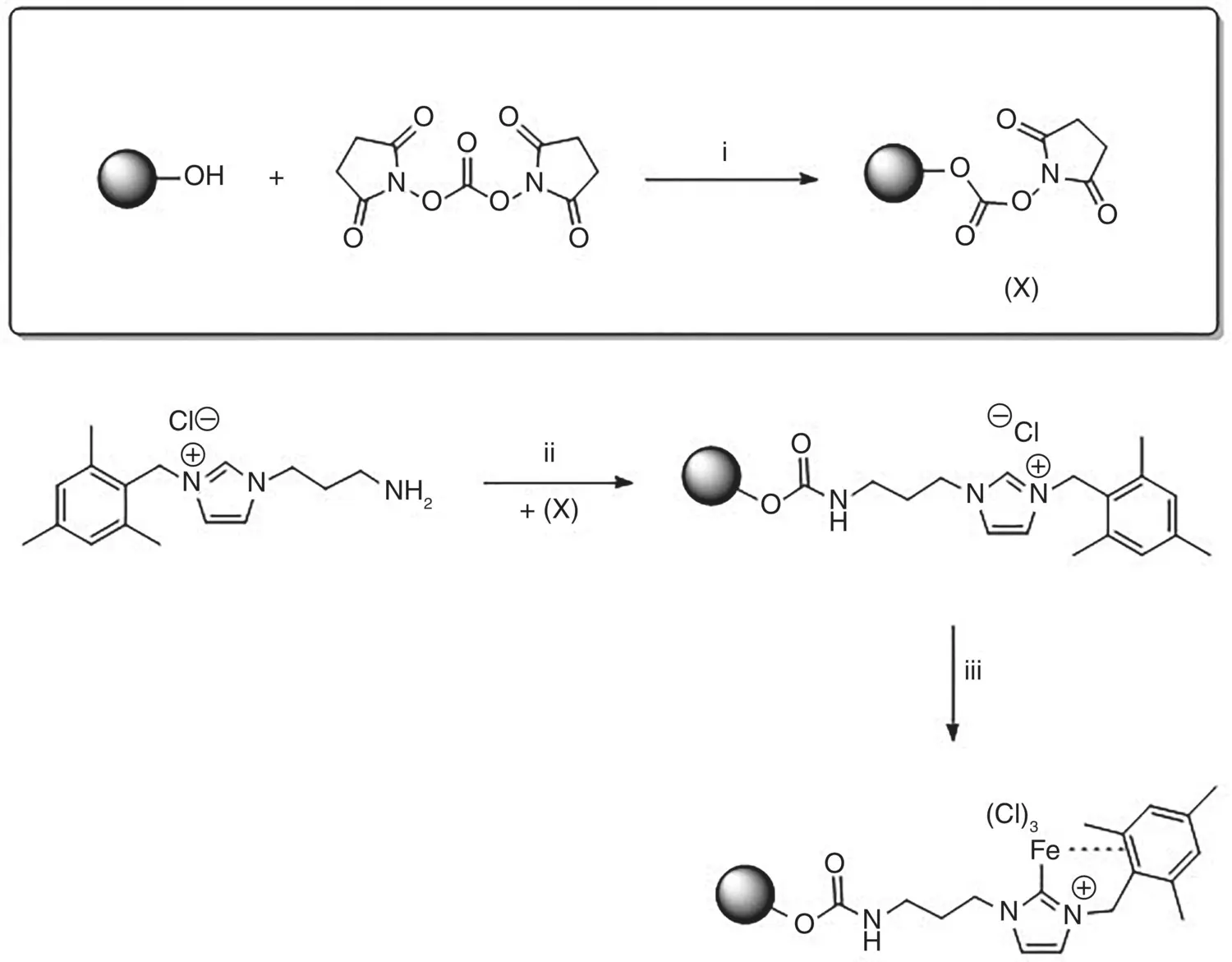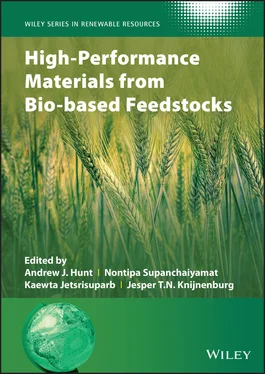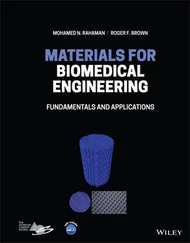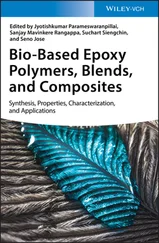High-Performance Materials from Bio-based Feedstocks
Здесь есть возможность читать онлайн «High-Performance Materials from Bio-based Feedstocks» — ознакомительный отрывок электронной книги совершенно бесплатно, а после прочтения отрывка купить полную версию. В некоторых случаях можно слушать аудио, скачать через торрент в формате fb2 и присутствует краткое содержание. Жанр: unrecognised, на английском языке. Описание произведения, (предисловие) а так же отзывы посетителей доступны на портале библиотеки ЛибКат.
- Название:High-Performance Materials from Bio-based Feedstocks
- Автор:
- Жанр:
- Год:неизвестен
- ISBN:нет данных
- Рейтинг книги:5 / 5. Голосов: 1
-
Избранное:Добавить в избранное
- Отзывы:
-
Ваша оценка:
- 100
- 1
- 2
- 3
- 4
- 5
High-Performance Materials from Bio-based Feedstocks: краткое содержание, описание и аннотация
Предлагаем к чтению аннотацию, описание, краткое содержание или предисловие (зависит от того, что написал сам автор книги «High-Performance Materials from Bio-based Feedstocks»). Если вы не нашли необходимую информацию о книге — напишите в комментариях, мы постараемся отыскать её.
High-Performance Materials from Bio-based Feedstocks
The latest advancements in the production, properties, and performance of bio-based feedstock materials
www.wiley.com/go/rrs High-Performance Materials from Bio-based Feedstocks
High-Performance Materials from Bio-based Feedstocks
High-Performance Materials from Bio-based Feedstocks — читать онлайн ознакомительный отрывок
Ниже представлен текст книги, разбитый по страницам. Система сохранения места последней прочитанной страницы, позволяет с удобством читать онлайн бесплатно книгу «High-Performance Materials from Bio-based Feedstocks», без необходимости каждый раз заново искать на чём Вы остановились. Поставьте закладку, и сможете в любой момент перейти на страницу, на которой закончили чтение.
Интервал:
Закладка:
Catalytic activity was very promising in the dehydration of fructose to 5‐hydroxymethyl‐2‐furaldehyde (HMF), with the expanded starch catalyst slightly outperforming the Starbon‐350 material (86% vs. 81% yield after 0.5 hour at 100 °C). Reuse was also very good, with consistent performance over 5 runs, and no discernible leaching of iron. Given the simpler route to the expanded starch material, it is clear that this is the catalyst of choice here.
While Matharu’s approach utilised the abundant hydroxyl groups on the surface of the material, Silva and co‐workers have described the synthesis of a chiral bis‐oxazoline catalyst on the surface of a Starbon‐700 material utilising the abundant unsaturation present in the higher temperature materials [24]. Given the low O content of these higher temperature materials, the typical functionalisation routes involving surface hydroxyls (i.e. reaction with silane esters such as (RO) 3SiR′ [30] and the succinimidyl carbonate route described earlier) are unsuitable. To circumvent this problem, Carneiro et al. [24] utilised a bromine functionalisation, reacting bromine with double bonds on the surface, to give a 1,2‐dibromo‐functionalised surface ( Figure 3.10). As the ligand to be attached is a diol, the formation of pairs of anchor sites close together is particularly attractive.

Figure 3.9 Synthesis of an N‐heterocyclic carbine‐based catalyst on the Starbon surface.
The resultant materials were used in the kinetic resolution of 1,2‐diphenylethane‐1,2‐diol. While activity was high, the enantiomeric excess of the process was significantly lower than that obtained by a solution‐phase process ( Figure 3.11). This was attributed to a low concentration of catalytic groups on the surface of the catalyst, and the high conversion suggests non‐chiral‐active sites may also be present.
3.2.3.1.6 Photocatalytic Processes
A further aspect of Starbon catalysis relates to the photocatalytic decomposition of water pollutants. Colmenares and colleagues have recently published work [32] that illustrates the excellent activity of Starbon‐based titanium dioxide photocatalysts for the total oxidation of phenol, one of the more toxic of water‐borne pollutants.

Figure 3.10 Preparation of a chiral bis‐oxalolidinone catalyst via surface bromination/displacement.

Figure 3.11 Selective acylation of a diol by a supported Cu‐bis‐oxalodinone/Starbon catalyst.
Part of the rationale for choosing Starbon as a support for the titania catalyst is that the TiO 2particles need to be nanoscale in order to have sufficient surface area to function efficiently. This raises two issues. First, separation of the nanoparticles from water is a major challenge, and second, agglomeration of the nanoparticles is a significant issue, which reduces the activity and efficiency of the catalytic system.
In their work, Colmenares et al. [32] utilised ultrasound‐assisted formation and deposition of titania onto thermally pre‐treated Starbon, avoiding the use of surfactants, and adding to the green credentials of the process. The materials were then dried and re‐calcined to produce a hybrid material containing 25 wt% of TiO 2. The authors suggest that carboxylic groups on the surface act as nucleation sites for the titania particles, which is further discussed in a second paper [33]. Interestingly, only the anatase form of titania was formed on Starbon, whereas similar amounts of anatase and rutile were produced on Norit, a standard activated carbon. This is important because anatase is the catalytically active form. The crystallinity was also found to be excellent on Starbon, meaning few defects are present – defects reduce the efficiency of the photocatalytic process by facilitating electron‐hole recombination. Graphene oxide seemed to produce almost no discernible crystalline material. Titania particle sizes for Starbon‐ and Norit‐derived materials were largely similar and in the range 20–30 nm. Loading of the inorganic phase resulted in a reduction in surface area by a factor of 1.6 for Starbon, and 1.3 for graphene oxide, but the microporous Norit suffered a sevenfold decrease in surface area.
Photochemical mineralisation of phenol was carried out using 50 ppm solutions of phenol in water, a Hg lamp (365 nm) and without bubbling of air through the solution (i.e. passive diffusion of oxygen into the solution). The Starbon materials had substantially greater activity than either Norit or graphene oxide‐derived materials, with the mineralisation rate constant being approximately 3 times higher for Starbon‐titania than for either of the other two systems. This was ascribed mainly to the pure, highly crystalline anatase phase formed on Starbon, as well as the mesoporosity of the system that allowed much better transport of phenol. Runs utilising Starbon itself also indicated that Starbon’s ability to adsorb phenol from the aqueous solutions was very good, meaning that it can pick up phenol from water and deliver it to the catalytic sites efficiently. Physical mixtures of Starbon and commercial anatase (Evonik P25) likewise showed excellent results, having approximately 50% higher rate constant than the ultrasound synthesised materials. Rate curves for the various systems indicated that Starbon‐based systems reduced phenol levels to 0.3% of the initial (i.e. to 0.3 ppm, well below the 1 ppm target) compared to 0.5 ppm for Norit and 0.7 ppm for graphene oxide. Not only were the final levels lower, but the rate of removal was faster as well.
3.2.4 Adsorption Processes
One of the classic uses of high‐surface‐area materials is the adsorption of dissolved or gas‐phase species, either with a view to concentrating and winning high‐value products, or to decontaminating waste streams, polluted air or environments. Starbon has been used widely in all these application areas, showing considerable promise in several instances, which are discussed next.
3.2.4.1 Adsorption of Gases
Milescu et al. [34] have published data on the adsorption of three toxic gases on starch, alginic acid, and pectin‐based materials and found some very interesting behaviour. The authors studied the room temperature adsorption of the gases from 5000 ppm in air mixtures, and looked at ammonia, hydrogen sulphide, and sulphur dioxide (separately). They found excellent adsorption in many cases, with materials outperforming standard activated carbons such as Norit, and also giving impressive results compared with a range of other adsorbents discussed in the literature.
For ammonia, adsorption was best with low‐temperature‐activated alginic acid material (in particular, the uncarbonised A000) with performance dropping to very low levels with the higher temperature materials. This correlates very well with the availability of acidic functionality (via the alginic acid‐repeating units) which is highest at carbonisation temperatures <200 °C. This functionality is lost above this temperature, and with it, the ability to adsorb ammonia drops dramatically. For both the starch and the pectin‐derived materials, there is no inherent acidity and the best performance for these materials is seen at 300 °C activation. This activity likely correlates well with a high level of functionality, including aldehydic/ketonic groups formed by dehydration of vicinal diols, and also possibly by ring scission. Such groups will readily form imines, trapping the nitrogen. Evidence for nitrile formation is also strong, possibly via dehydration of primary amides, from acidic functionality that can also develop during carbonisation. Further carbonisation leads to the gradual loss of this rich functionality, leading to a reduced ability to adsorb ammonia.
Читать дальшеИнтервал:
Закладка:
Похожие книги на «High-Performance Materials from Bio-based Feedstocks»
Представляем Вашему вниманию похожие книги на «High-Performance Materials from Bio-based Feedstocks» списком для выбора. Мы отобрали схожую по названию и смыслу литературу в надежде предоставить читателям больше вариантов отыскать новые, интересные, ещё непрочитанные произведения.
Обсуждение, отзывы о книге «High-Performance Materials from Bio-based Feedstocks» и просто собственные мнения читателей. Оставьте ваши комментарии, напишите, что Вы думаете о произведении, его смысле или главных героях. Укажите что конкретно понравилось, а что нет, и почему Вы так считаете.












